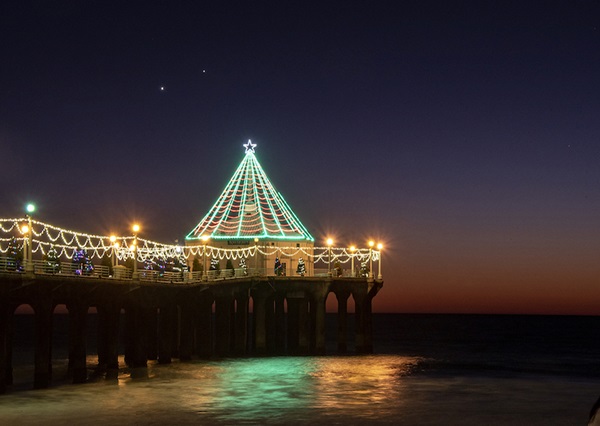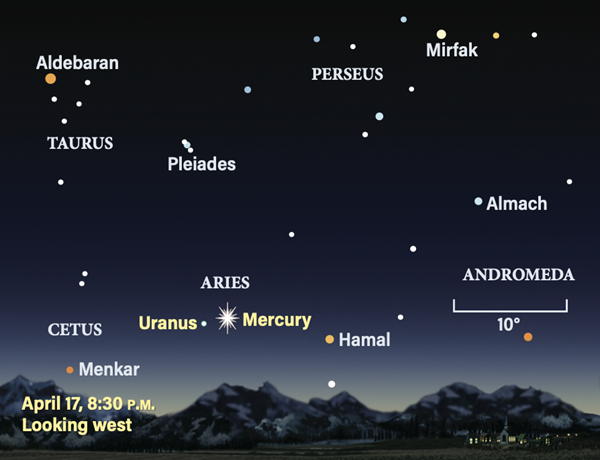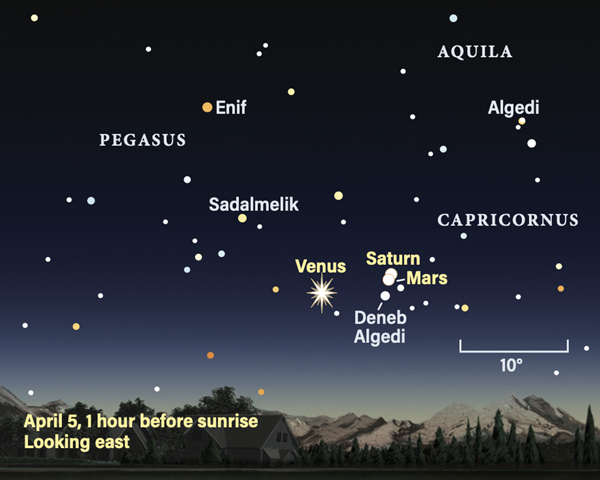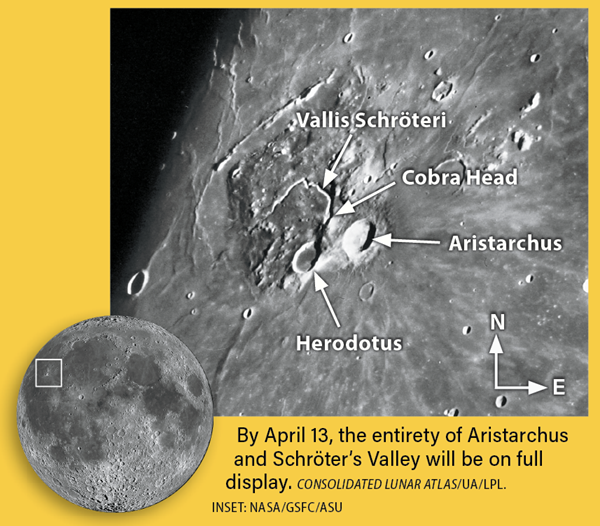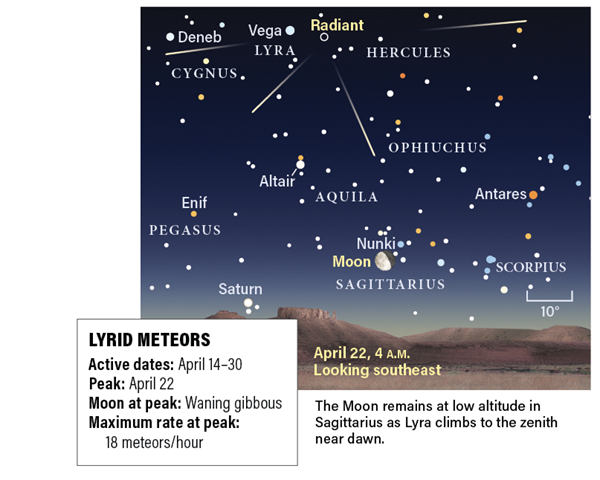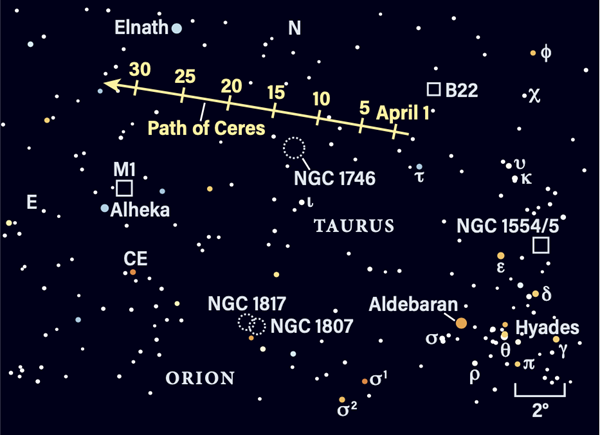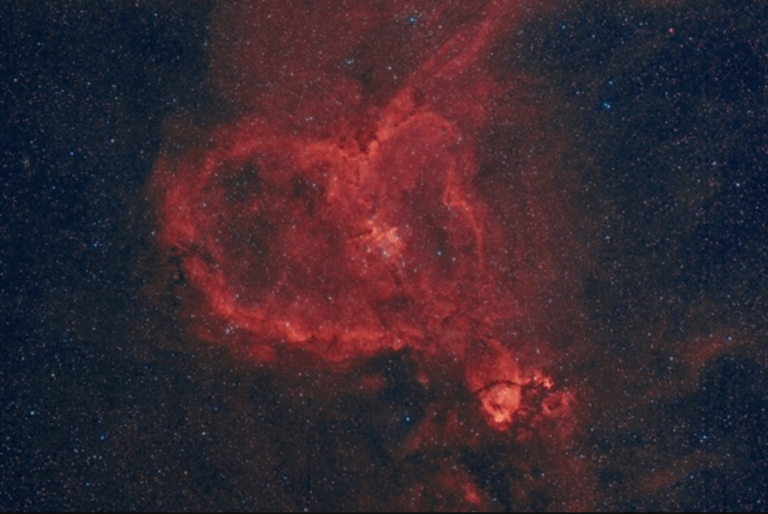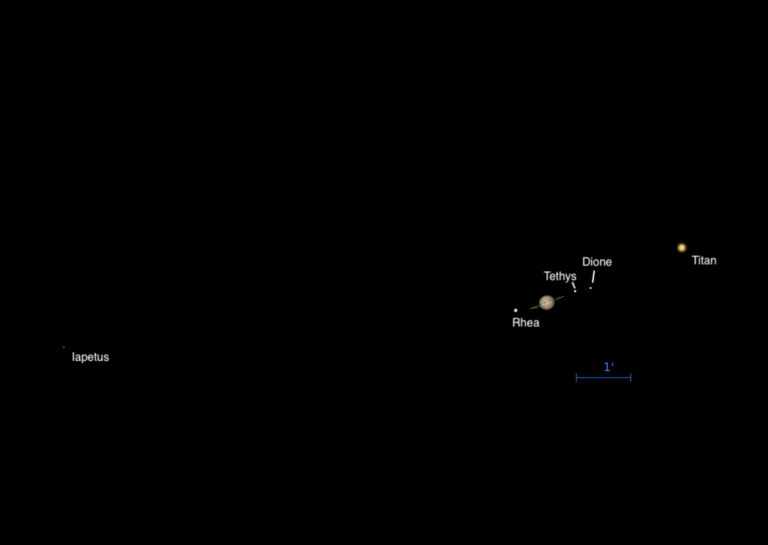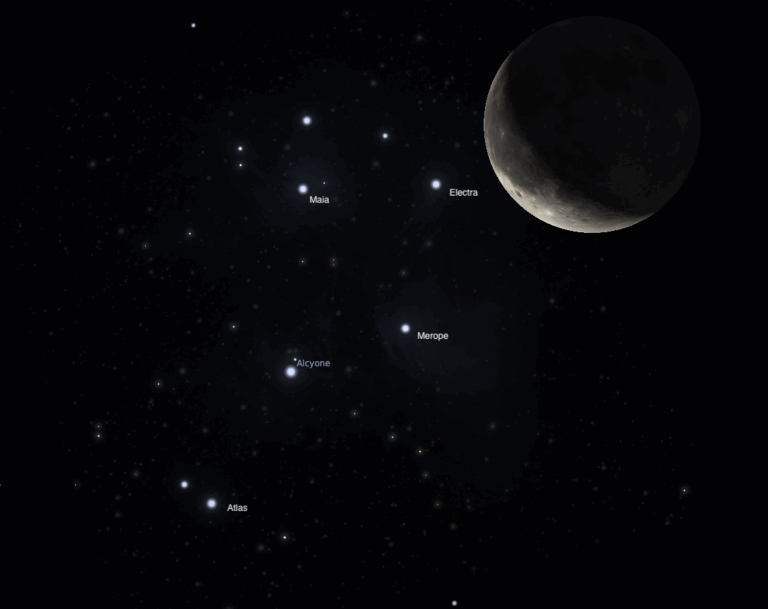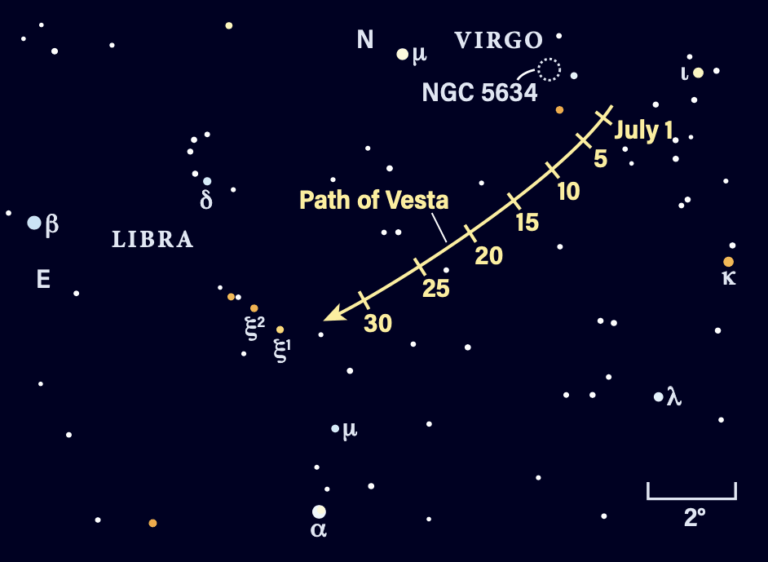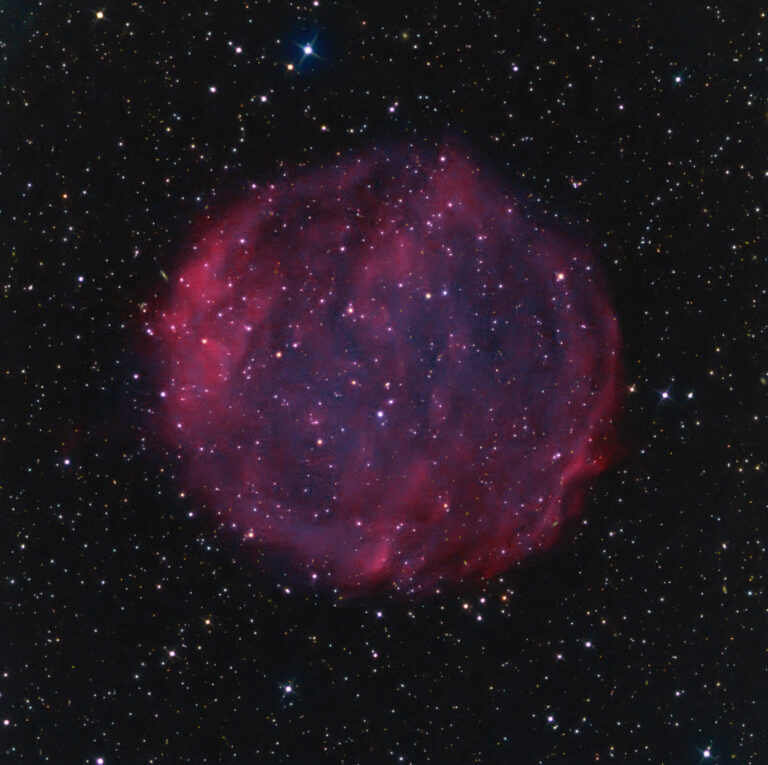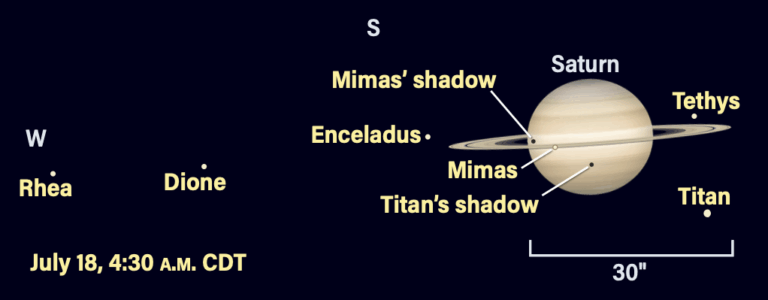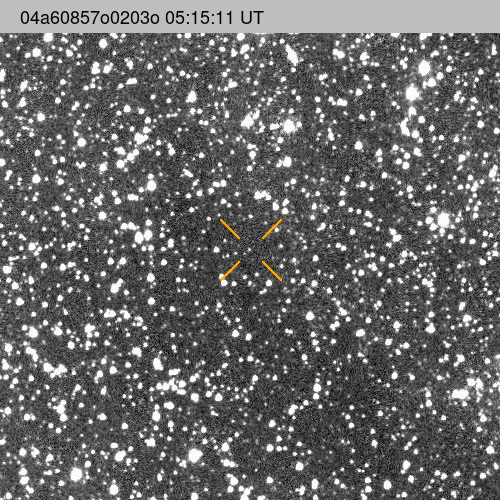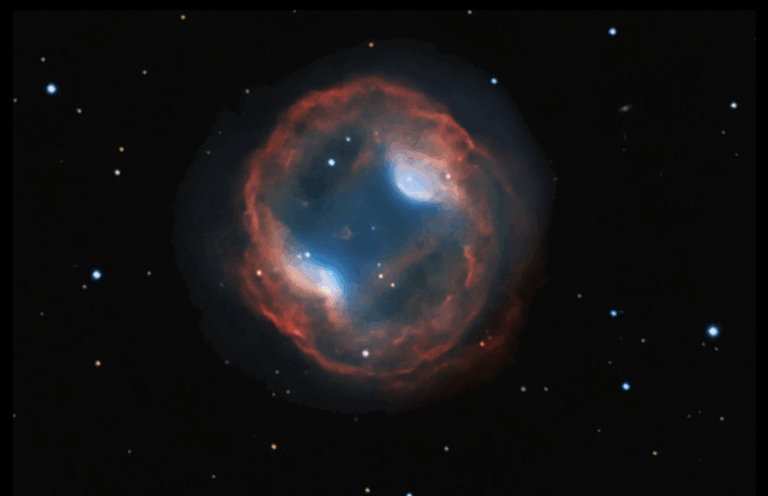Key Takeaways:
Mercury is at its best for Northern Hemisphere observers this month. It’s a highlight in the evening sky. The rest of the planetary action takes place in the morning, with the finest conjunction of the year between the two brightest planets, Jupiter and Venus, on the last day of the month. In the run-up to that conjunction, Mars, Venus and Saturn open the month in a fine display that constantly changes appearance and makes April mornings a good time to spring out of bed early and catch the continuing spectacle each day.
Mercury achieves its best evening appearance of 2022 this month. Following its superior conjunction with the Sun on April 2, Mercury springs upward in the western evening sky and reaches greatest elongation just four weeks later. The high inclination of the ecliptic to the western horizon at this time of year further aids its visibility.
Can you spot Mercury at the end of April’s first week? It shines at magnitude –1.8 and sets within 30 minutes of the Sun — certainly a challenge if your western horizon is blocked by trees or buildings.
Circumstances improve rapidly as Mercury climbs higher in altitude each consecutive evening. On April 9, it stands about 1° high 30 minutes after sunset but by the 13th, it’s 5° high, shining at magnitude –1.4, and sets an hour after the Sun. By the 16th, it’s an easy object, remaining above the horizon 75 minutes after sunset and magnitude –1.2. The misty glow of the Pleiades star cluster (M45) hangs some 18° above the planet. The cluster slowly appears as twilight darkens.
There’s a rare chance on April 17, when Uranus and Mercury stand 2° apart and share a binocular field. Uranus, located 20 times farther than Mercury, is due south of the innermost planet and appears left of Mercury in the western sky. Begin searching around 8 P.M. local time to find Mercury about 10° high. As the sky darkens and the planet descends, look for Uranus to the left of Mercury — after 15 minutes, it should come into view. Uranus shines at magnitude 5.9 and becomes more difficult to see through low-altitude haze as time progresses. The ice giant stands a fraction of a degree north of Omicron (ο) Arietis, which is roughly the same magnitude, so search for two objects half a Moon’s-width apart. The one closer to Mercury is Uranus.
Mercury’s continued progress through the sky creates a lovely scene with the Pleiades later in the month. Beginning April 27, the planet lies within 2.5° of the cluster and closes in to sit 1.5° due south on April 29. The same evening, Mercury attains its greatest eastern elongation of 21° from the Sun. By the end of the month, the small planet has faded to magnitude 0.5 and stands 8° high an hour after sunset.
Track Mercury with a telescope to watch its month-long series of changes, as it morphs from a fully lit disk spanning 5″ on April 1 to a 33-percent-lit crescent 8″ wide by April 30.
Set an early alarm to catch the remarkable collection of planets that congregate in the predawn sky this spring. Venus, Mars, and Saturn are up together, located in eastern Capricornus the Sea Goat.
Mars rises first on April 1, shortly before 5 A.M. local time. It’s followed by Saturn and Venus within few minutes of each other, all about two hours before sunrise. Venus will be most obvious if you have any early morning haze, as it is a dazzling object at magnitude –4.4. Saturn, at magnitude 0.7, lies less than 4° to the right (southwest) of Venus. Mars is a relatively dim 1.1 and stands 2.4° to the upper right (west) of Saturn. Note that the Red Planet is too small for decent telescopic views. It will reach opposition at the end of the year.
The distance between Venus and Mars is just over 6°. As the three planets clear the horizon over the next hour, they’re a sight to behold. By the start of nautical twilight, around 5:45 A.M. local time for latitudes near 40° north, the trio stands nearly 10° high in the eastern sky. Capricornus has never looked so bright.
As April progresses, Venus and Mars continue to trek eastward against the starry background, while the more distant Saturn barely moves at all. By April 5, Mars and Saturn meet, moving from 30′ apart on April 4 to 24′ apart on April 5. Mars spans 5″, while Saturn’s disk is 16″ wide, even though Saturn is more than five times farther from Earth than Mars. Note their color contrast — the ruddy surface of Mars reflects sunlight differently than the yellowish clouds of Saturn.
Beginning April 4, Venus moves into Aquarius and continues its eastward path, extending its distance from the Red Planet. Mars crosses into Aquarius April 12 and lies 9.5° west of Venus on that date, while Saturn stands 5° west of Mars. A waning Moon joins the scene on April 24, less than 9° from Saturn. The following morning, April 25, the Moon has shifted east and lies below the line connecting Mars and Saturn, with the planets standing 8.5° northeast and northwest of the Moon, respectively. Venus and Jupiter are just 5° apart the same morning, offering a tantalizing prelude to an amazing conjunction a few days later.
On April 27, a 26-day-old crescent Moon sits 4° below Jupiter, with Venus 3° to the gas giant’s west. The planetary pair rises in a dark sky around 4:30 A.M. local time, followed by the crescent Moon 20 minutes later. As civil twilight begins, the planets stand 11° high in the eastern sky, with the beautiful Moon, earthshine illuminating its dark hemisphere, hanging below them. Jupiter shines at magnitude –2.1, compared with Venus at magnitude –4.1.
Don’t forget to grab binoculars or your telescope that morning, because there’s another planet in the same area: Neptune sits less than 24′ from Venus. At magnitude 7.8, Neptune is a binocular object and the advancing twilight will cause it to fade out of view, so catch it within an hour of Venus rising. A telescope will show the pair nicely, Neptune’s bluish glow contrasting spectacularly with the brilliant white of Venus, whose 66-percent-lit gibbous disk spans 17″. Neptune is just 2″ wide and is difficult to resolve at such a low altitude.
The grand finale of April’s planetary events occurs on the 30th with a conjunction of the two brightest planets, Venus and Jupiter. Venus shines at magnitude –4.1 and Jupiter is dimmer but still brilliant at magnitude –2.1. They’re just 28′ apart, less than the width of the Full Moon. Jupiter spans 35″ and is accompanied by three of the four Galilean moons: Io, Ganymede, and Callisto. Europa is hidden behind the planet for Midwestern observers; those on the East Coast will see Europa disappear behind Jupiter, while western skywatchers see its reappearance. Venus now shows a 67-percent-lit disk 17″ wide.
Follow the pair into twilight and even after sunrise — if your telescope is tracking, you can continue view these bright planets into daylight. This is worthwhile because around 3 P.M. EDT (12 P.M. PDT), the two planets are only 12′ apart, with Jupiter due north of Venus. While there are more conjunctions visible in the next few years between these planets, none come this close at an elongation well away from the Sun until November 2039.
Rising Moon: Amazing Aristarchus
“There is something happening on the Moon!” Like so many observers before me, I was jolted by a striking blaze of flickering light on the terminator and called out to my fellow observers to come see. I am eager to relive that experience April 12, when the Sun illuminates the brilliant western flank of Aristarchus. Earth’s turbulent atmosphere may add some colorful scintillation to produce a very memorable sight.
For a few moments, forget that the Moon’s volcanoes are long dead and just enjoy this theatrical simulation of an eruption at Aristarchus, situated in the lunar northwest. Start right at sunset and continue to watch the visual drama unfold over the next few hours, as more of the rim appears and its inner walls light up. Generation after generation of smart, sharp-eyed astronomers managed to convince themselves there really was something going on here. Would you too have risen to that bait?
One evening later, look for a diamond-shaped plateau protruding above the surrounding lava-flooded plain. Just west of the blazing crater, note the long snakelike Vallis Schröteri (Schröter’s Valley). This 6-mile-wide channel was carved out by a flow of lava that must have been truly awesome, dwarfing anything humans have witnessed on Earth. Nearest Aristarchus, it stops at a shadowed volcanic vent in a wider zone aptly named the Cobra Head.
Aristarchus is so bright it is easily seen when the Moon is bathed in earthshine. Just after New Moon, the farside faces the Sun while the nearside experiences night. Yet Luna’s familiar face is flooded with a blue-green light as it gazes at the nearly full Earth, poised almost motionless in the lunar sky. This happens on the 2nd, when the Moon is but a thin, waxing crescent in our evening sky. Train a scope on it and pick out the bright patch in the northwest. For fun, bump up the power and take a tour in this ashen light.
Meteor Watch: Decent prospects
The Annual Lyrid meteor shower is active from April 14 to 30 and peaks the night of April 22. Its radiant rises in late evening and stands about 30° high at local midnight. This offers a few hours of dark skies before the 21-day-old Moon rises on the morning of the 22nd.
Meteors are always more prevalent in the hours before sunrise because the relative impact speed of shower particles on Earth’s atmosphere is higher. As you prepare for the morning display of planets, which rises in the east soon after 4 A.M. local time, keep a lookout for the occasional flash from a Lyrid meteor. The Moon will slightly diminish the number of meteors you see. However, Lyra is above 80° in altitude by now, so you could catch 5 to 10 brighter shower members per hour.
Comet Search: Better than NEOWISE?
It’s a fool’s errand to think one can reliably predict a comet’s maximum brightness, but C/2021 O3 (PanSTARRS) has the right characteristics on paper to become the comet of the decade. Could it fizzle? Yes. But with potential disappointment in mind, let’s hope the following evening scenario comes to pass.
Those south of the equator get the first glimpse on the 10th with binoculars, watch it flower into a wonderful sword straight up from the horizon, then all but lose it by the 30th. In the lowest 48 states, the core may rival Mercury on the 21st, as the comet reaches its closest point to the Sun. An ion or sharp dust tail could become visible as twilight deepens. The rest of North America joins in on the 23rd or 24th, when the comet is at peak brightness. Ensure you are away from the city with a clear western horizon shortly after sunset. The comet sets all too quickly as twilight deepens.
Don’t worry about fading post peak: PanSTARRS climbs into a darker sky night after night, increasing the contrast of its tails against the deep blue twilight. When comets pass between us and the Sun, the brightness boost from forward scattering can be amazing. The geometry is only a bit less favorable and it could last through the first week in May. Consider traveling if you must for this spectacle!
Locating Asteroids: Still on the Bull
As darkness falls, dwarf planet 1 Ceres stands halfway up the western sky. It’s above Aldebaran, crossing the northern horn of the celestial bull. Barely fading from a modest magnitude 8.9, Ceres is a good target for a small scope from the suburbs. In a nice coincidence, it is passing in front of the sprawling dark nebula Barnard 22, a huge zone of dust and gas that many million years from now will light up with brand-new massive stars.
To see the ruler of the asteroid belt shift relative to the stars in one session, try the nights of April 7 and 8. Make a simple sketch of the five brightest stars in the field and come back in two hours to identify the moving one.
On the evenings of the 11th through the 13th, drop south one degree to notice a widely scattered spray of stars a bit brighter than Ceres, covering almost two apparent moonwidths of sky. This is the open cluster NGC 1746. With his narrower field of view and darker sky, the skilled visual observer William Herschel discovered two separate concentrations of stars within the larger object. These and B22 do require a darker sky.
When Ceres returns to opposition next spring, it will be the closest it’s been since 2005, glowing at magnitude 7 — nearly the brightest it can ever get.

